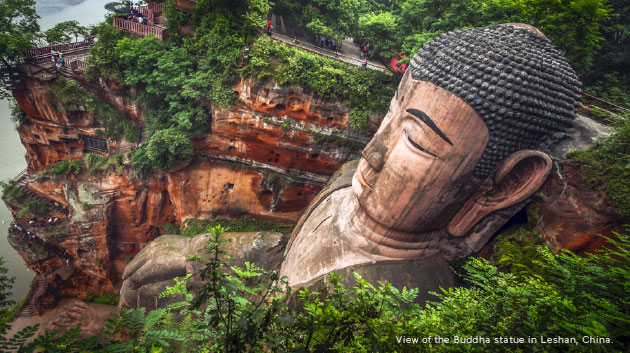Inhumane China Has No Trace Left of Its Former Buddhist Glory
(View of the Buddha statue in Leshan, China.)
Key points in this article:
- Zhiyi (T’ien-t’ai Chih-i) established the high point of Chinese Buddhism
- Esoteric and Zen Buddhism flourished in Imperial China
- Japan must repay China by spreading Buddhist teachings there
It was recently reported that Liu Xia, wife of Nobel Peace Prize laureate and human rights activist Liu Xiaobo, arrived in Germany following her house arrest in China.
This is happy news, but as The Liberty Magazine has been reporting, human rights oppressions are continuing in China. The persecution of Buddhists, Christians and Muslims has been getting worse each year.
“You [the Japanese people] must turn China into a Buddhist country once again.”
So said the spirit of Winston Churchill when summoned for a spiritual interview by Master Ryuho Okawa, founder and CEO of Happy Science, last month.
China was indeed a huge Buddhist country. There are still many temples left, and it still has followers in the private sector. To stop China’s oppression of human rights there is a need to spread religious teachings around the whole country. So this article will briefly look at the history of Buddhism in order to discover the potential for spreading beliefs in a materialist country like China.
Zhiyi Achieves the Pinnacle of Chinese Buddhism
One of the most famous Buddhist monks from China is Zhiyi, also known as T’ien-t’ai Chih-I (583-597 CE). Zhiyi’s sutras, most importantly the Mohe Zhiguan and his commentaries on the Lotus Sutra, had a huge impact on the course of Buddhism throughout Asia.
In China at the time, all sutras that were brought into China already translated were thought to be the direct words of Buddha. This gave rise to difficulties and countless debates when monks were faced with teachings full of contradictions and diversity.
Zhiyi took those sutras and evaluated them, finally concluding that the central teaching ought to be the Lotus Sutra as it was the final and highest teaching of Buddha.
The first half of the Lotus Sutra teaches that Buddha nature resides in all people, and the latter half teaches about the Eternal (as opposed to the human) Buddha. Zhiyi based his decision on these two teachings.
In his book “The Golden Laws” Master Okawa writes as follows:
T’ien-t’ai [Zhiyi] continued to receive instruction from Shyakamuni [Buddha] on numerous occasions until he attained true enlightenment and was able to communicate freely with the spirit world. By 594, when he preached his Discourse on Mahayana Meditation and Contemplation, he had already arrived at the full enlightenment of the Tathagata.
So Zhiyi achieved the pinnacle of Chinese Buddhism.
When Master Okawa summoned the spirit of Zhiyi in December 2015, Zhiyi spoke about how China used to be a Buddhist country:
China is a matter of time: during [the next] generation it will become a base for the propagation of Happy Science . . . I don’t know how far you will get during Ryuho Okawa’s time on Earth, but by your generation – the next generation – missionary gatherings will be taking place quite freely all around China. That’s the scale I anticipate.
Esoteric and Zen Buddhism Was Widespread in China
Esoteric Buddhism (Vajrayana) also entered China, and was developed to an advanced level.
Subhakarasimha (637-735 CE), an Indian monk, translated the important Esoteric text the Mahavairocana Tantra into Chinese and thus introduced Esoteric Buddhism into Tang China. Another Indian monk Vajrabodhi (669-741 CE) spread Esoteric teachings in Chang-an and, similarly, Amoghavajra (705-774 CE) studied under Subhakarasimha and translated texts such as the Vajrasekhara Sutra into Chinese, thus spreading Esoteric Buddhism in the Tang dynasty.
One of Amoghavajra’s disciples was Huiguo (746-805 CE) and he combined the teachings of the two last mentioned sutras. Then along came a monk from Japan by the name of Kukai (774-835 CE).
After Kukai became the 8th master and therefore the successor of Esoteric Buddhism, Buddhism in China went into a decline. As an aside, Esoteric Buddhism itself was not the direct teachings of Buddha but comes more from ideas of Hindu magic.
Around 400 years later in the Song dynasty, however, the Zen master Wumen Huikai wrote The Gateless Barrier, a collection of Zen koans, and revived Buddhism in China.
The Possibility That Buddhist China Will Return
There is still soil in China where seeds of Buddhist ideas can be planted. As the blind Chinese activist Chen Guangcheng told The Liberty Magazine, “Since ancient times China has been influenced by Taoism and Buddhism. The Communist Party is atheist, but many of the people still believe in spiritual things. I too believe in a supernatural power beyond human capacity.”
During Master Okawa’s spiritual interview with the spirit of Chinese revolutionary Sun Yat-sen in February 2012, the spirit mentioned that, “If the people hear of the ‘Rebirth of Buddha’ and all flock to the Buddhist temples, it will become like what happened in India, Nepal and Sri Lanka [after Master Okawa’s visit]. If the people enter Buddhism it will be no easy task for the authorities to eradicate them”.
During the Qing dynasty the Buddhist initiated a revolutionary movement known as the White Lotus Rebellion (1796-1804). There is still a possibility to spread religion into China and precipitate the collapse of the Communist Party. And if there were a principle player in that game, it would have to be a new religion with Buddhist ideas at its core: Happy Science.



















